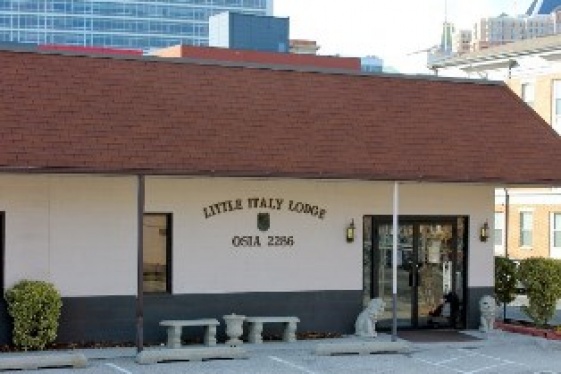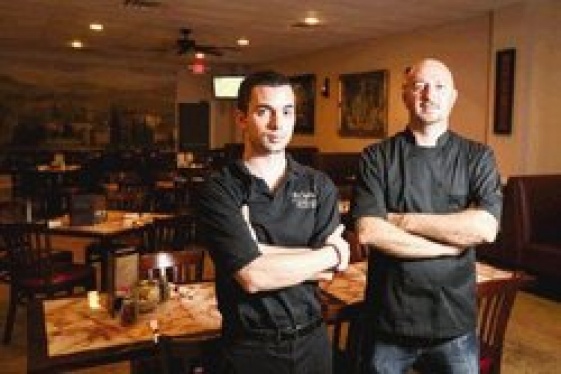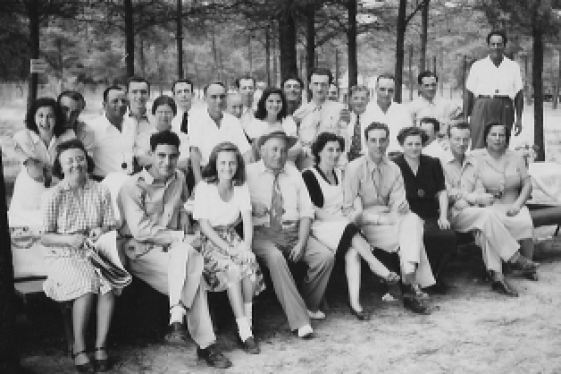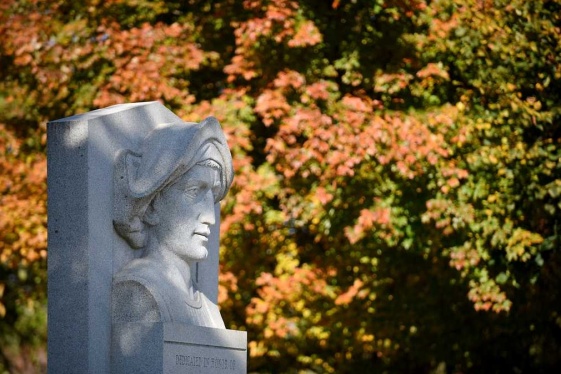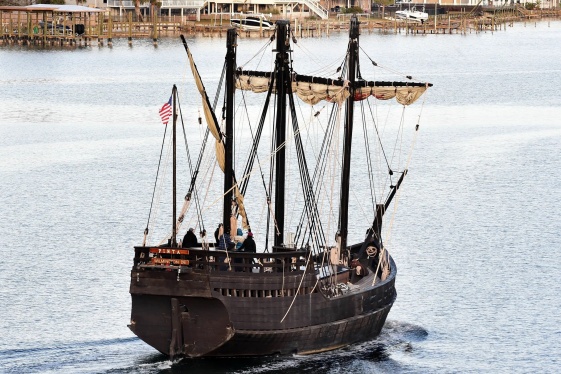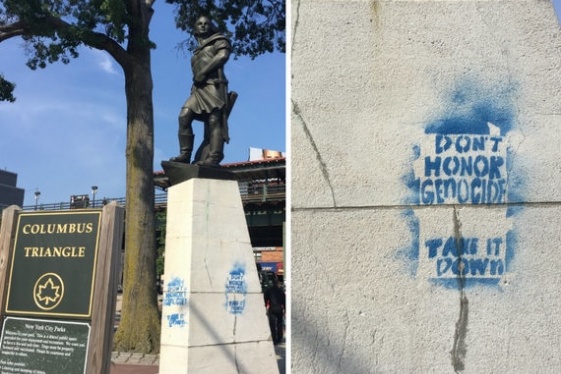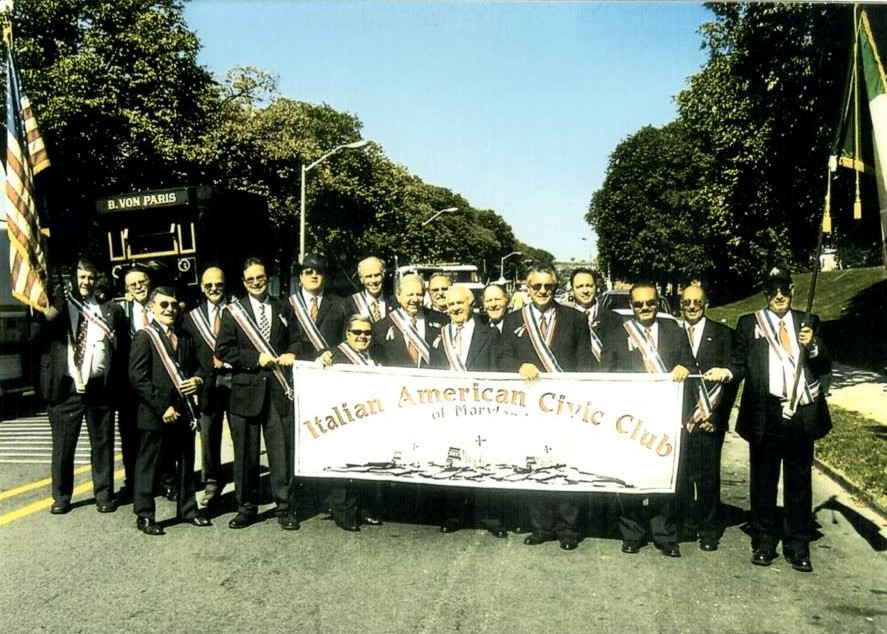
Letter sent by the Italian American Civic Club of Maryland Inc. to the Baltimore Mayor and city Councilmembers on Thursday June 25th

BY: The Italian American Civic Club of Maryland,Inc.
This is the letter that the Italian American Civic Club of Maryland Incorporated sent out to the Baltimore Mayor and city Councilmembers on Thursday June 25th (9 days prior to the destruction of the statue). The city received plenty of notification to prepare, but they did not lift a finger when the mob came in the Columbus Plaza. It also included an attachment about historical information about Colombo
Honorable Mayor Jack Young, Baltimore City Council President Brandon Scott, and Baltimore City Council Members: On behalf of the Board of Governors and membership of the Italian American Civic Club of Maryland, Inc., we urge you to take needed precautions to protect the statues of Christopher Columbus in our city; the Columbus statue in Druid Hill Park, the Columbus Obelisk in Harford Road, and the Columbus Statue in Little Italy and to strongly oppose the proposed City Council Bill 20-0549 to rededicate the Columbus Obelisk to some other purpose. As you know, our statues have received specific threats from organized groups on social media posts. Here is a picture that shows a cone resembling a KKK hood placed on the top of the Columbus statue in Little Italy on June 21, 2020.
Another Twitter post included a warning directed against Mayor Jack Young, which stated that in 48 hours from the post (i.e., Wednesday June 24, 2020) these two Columbus statues will be destroyed or removed.
We are appalled by these threats and acts of vandalism. We are deeply concerned by the provocative act of placing of the KKK hood on the Columbus statue—especially in light of the history of past discrimination against Italian Americans perpetrated by the Ku Klux Klan and other white supremacy groups. We feel compelled, once again, to bring to your attention that we in the Italian American community are together with you against fighting against racism, violence, and abuse.
It is undeniable that American citizens of African descent have been victims of systematic racism in the United States and have been the most affected victims of lynchings occured in recent times. Those lynchings were perpetrated with the consent of a large part of the U.S. population who attended the performance of these murders by hundreds of thousands and took part in these dehumanizing acts in order to intimidate and terrorize thousands of our fellow African American brothers and sisters. Although not comparable to the number experienced by African American communities around the county, we Italian Americans also experienced this horrible page of our national history through our innocent Italian ancestors (mainly of southern origins) whose blood was spilled in cities like Erwin (MS), Eureka(NV), New Orleans and Tallulah (LA); Denver (CO), Tampa (FL), and many other cities in the United States. We are bringing these lynchings to your attention to unveil the important fact that the building of Christopher Columbus statues in the U.S. occurred mainly in connection to these horrible lynchings that caused fear and terror in our Italian American communities from south to north and from east to west during the late nineteenth and twentieth centuries.
The very statue now standing in Druid Hill Park was built and dedicated in 1892, and like many Columbus statues built and financed by local Italian American communities in response to the largest single mass lynching in U.S. history, which occurred in New Orleans on March 14, 1891. The lynching occurred after the murder of popular Police Chief David Hennesy in New Orleans. A mob acted as vigilantes and broke inside the prison where about 20 Sicilians were held there after the trial. Although they were all acquitted after a trial, eleven of them were seized and publicly executed on March 14, 1891. The brutal murder went unpunished, and even received praises and positive headlines on various newspapers of the time. Theodore Roosevelt (who became president three years after this event) suggested the lynching was “A rather good thing.” Only recently, New Orleans Mayor LaToya Cantrell (the first African American woman to hold this position in the city's 300-year history) issued a public apology on April 2019 at an Italian-American cultural center in the city.

After this unprecedented massacre various Italian communities throughout the United States immediately planned, financed, and lobbied their local governments in building marble statues of Christopher Columbus throughout the United States. In doing so, Italians wanted to state their worth as Americans and avoid more killings and lynchings against Italian Americans. This unfortunately did not happen as racial attacks continued throughout the United States. A few years later 5 Italians were lynched again in Tallulah, LA; many other lynchings occurred in Nevada, Mississippi, Kentucky, Colorado, Arkansas, and West Virginia.

In 1910 there was the infamous double lynching perpetrated against two Italians in Tampa, Florida.

Rampant discrimination, aggression and violence against Italians continues in the 1920-40’s by the Ku Klux Klan, who perpetrated murders and abuse against Italians for their Catholic upbringing. Here below you can see a popular cartoon used by Ku Klux Klan members (and even printed in popular newspapers of the time) that not only mocks Italians, but also states the need to exterminate them from the face of the earth.

Although the Columbus Statue in Little Italy was built more recently in 1984, it aimed to continue to honor Italian Americans and fight this past tradition of injustice, violence, and murder. Its main objective is to preserve and honor the good name of Italian Americans in the City of Baltimore.
We would like to conclude this plea to you to defend our heritage and statues by also voicing our strong opposition against the proposed City Council Bill 20-0549 to rededicate the Columbus Obelisk to some other purpose. Although built in 1792, the Columbus obelisk became the symbol of the said struggles endured by our Italian American community as evident by this picture: October 1950. The Columbus Obelisk receiving a wreath of honor by Mayor Thomas D’Alesandro Jr., with 10-year old Nancy (D’Alesandro) Pelosi.

For some it might be a simple change of names, but for many of us in the Italian American community here in Baltimore will be an infringement of our right to exist in the United States of America where Italian Americans (especially in the state of New York that has the highest number of Italians in the country) are the only national origin population established as an affirmative action category protected under Executive order 11246 since 1976. Italians are therefore considered as a protected class under affirmative action guidelines. If this bill were to pass, (once again) we shall resort to any legal means available to us to ensure our right to exist.
That is why we implore you to help us preserve these Columbus memorials, which for us who are part of this history are not related to slavery or racism, but quite the opposite. They are our own sanctuaries and even graves built from the innocent blood of our Italian ancestors killed by white supremacists and KKK members. Columbus reminds us all in the Italian community that we are Americans too, despite the numerous attempts of dehumanizing us with slurs, stereotypes or brutal murders. We stand from the bottom toward our African American brothers and sisters in hope that from the ugly darkness of prejudice and hate a new heaven and a new earth will arise—not only for our own Baltimore community, but also for all immigrants that are still coming from Africa, Asia, Europe, the Middle East, and South America hoping to see a better future; a future of honesty, unity, and mutual respect.
Thank you very much for your time and consideration of these important matters.
Most Sincerely,
The Italian American Civic Club of Maryland,Inc.
POST SCRIPTUM: Please find enclosed some documents arranged by historian Josè G. that provides us all with a more comprehensive picture of Columbus and his perception, which has been undeservingly distorted by influential publications such as A People's History of the United States by Howard Zinn. Although Dr. Zinn wanted to shed light on the reality of colonization, and introduced a different perspective on American history, he perpetrated many distortions. His acts of distortion were damaging for many people, especially for the African American community at Spelman College where he worked. For that reason, he was fired by Dr. Albert Manley, the first African American president of Spelman College, America's oldest private historically black liberal arts college for women. Dr. Manley felt that Zinn was radicalizing the African American students at Spelman, and indeed his ideas had (and continue to have) a negative impact upon many communities. https://www.insidehighered.com/news/2013/07/18/mitch-daniels-renews-criticism-howard-zinn
A good resource to approach Howard Zinn’s influential (and damaging) work is Mary Grabar’s book Debunking Howard Zinn: Exposing the Fake History that Turned a Generation against America
https://www.amazon.com/Debunking-Howard-Zinn-Exposing-Generation-ebook/dp/B07NLGWS6F
All citations from the lyncings of Italians could be found in Patrizia Salvetti’s book The Rope and Soap: Lynchings of Italians in the United States, New York: Bordighera Press, 2012
Bartolomé De las Casas’s writings regarding Columbus (José G., Historical Researcher of Spanish and Caribbean History)
Most of the narrative you may be aware of regarding Christopher Columbus actually comes from the pen of Fray Bartolomé De Las Casas- the Archbishop of Chiapas greatly recognized for his advocacy of the Indigenous peoples of America. It is through this window of text that people cast their opinions about the historical personage of Columbus.
Understanding this, when people say “Columbus’s own letters” what they are really referring to is De las Casas’s transcription of some of Columbus writings missing since 1522. The remaining sources of the Columbian narrative come from a much more important work of De las Casas, ‘Historia de las Indias’ (1527 to 1559)- a three-volume work splayed across 18,340 pages of writings. Different iterations recorded within his text exist with dual perspectives because De las Casas alternated his writing from “these are the Admiral’s words” to “this I saw”. This style of writing -De las Casas’s prose- also formulated many thoughts into each of his sentences to project a multidimensional context of what he either witnessed or read from other text sources (including some writings of Columbus himself, once housed at the Columbian Library in Seville and curated by his son Hernando). So, because all of this inherent impreciseness lodged into his writings one should avoid shortening sentences or omit full paragraphs that appear in his text. It is also best to study the history interwoven into the redaction in order to gain a broad insight of what the friar was attempting to frame.
What follows then are poor examples of interpretations found today within U.S. circulating texts attempting to incorrectly decipher what De las Casas wrote: out of context meanings, grave omissions and mistranslations that have permeated into his writings, because of the improper manner (intentional or not) they approached his manuscripts.
Example 1: When De las Casas mentions Columbus’s description of the Lucayans he first encountered in Guanahaní-
Columbus wrote in his journal: "…they would make good servants ...With fifty men we could subjugate them...” [‘A People’s History of the United States’, Howard Zinn- Ch. 1: Columbus, The Indians, and Human Progress, rev. 1999]
Besides this quote being actually two separate sentences joined by ellipses (making it of ambiguous source), you must inspect this interpretation by reading from the beginning of the paragraph where he asks the Lucayans about the scars he visibly saw on their arms and legs. That whole sequence of sentences was all a singular thought: The Lucayans told him neighboring peoples were trying to take them as prisoners but they fended them off; Columbus thought the others must see them as good servants. Since the Lucayans also repeat back everything they are told, with those qualities and little struggle they could eventually become good Christians. This can be observed by examining the manuscript facsimile from 1556, focusing on the sentence flow and punctuation compared for clarity (see Exhibit A).
“I saw some who had signs of wounds on their bodies and I pointed to what those were: they showed me how people from other islands that were nearby came by but wanted to kidnap them so they defended themselves and I believed and still believe that they came from the mainland to take them as captives. They must be good servants and of good wit for I see they very quickly say everything that I say to them: and I think that lightly they will become Christians because I believe they do not have a religion.” [‘Relaciones y cartas de Cristóbal Colón’, Librería viuda de Hernando Colón 1892]
Many writers have translated this text into English substituting “must be” with “would” or “should”, changing the context to appear as if Columbus was only interested in the Lucayans’ potential for being slaves. His comment was a first impression on how they appeared to him on two counts and why. Do not forget, he also just finished meeting the new Americans for the first time.
Example 2: Another popular “interpretation” made from De las Casas’s writings is on Columbus’s interaction with the island Indigenous later in his second voyage. This paragraph is often quoted as depicting his treatment of the people known as Taíno and it is part of a text from a very popular book found in schools throughout the U.S.: “In the province of Cicao on Haiti, where he and his men imagined huge gold fields to exist, they ordered all persons fourteen years or older to collect a certain quantity of gold every three months. When they brought it, they were given copper tokens to hang around their necks. Indians found without a copper token had their hands cut off and bled to death.” [‘A People’s History of the United States’, Howard Zinn- Ch. 1: Columbus, The Indians, and Human Progress, rev. 1999]
There are multiple problems with this text, the most important one being that the actual historical document DOES NOT MENTION NOR IMPLY CUTTING HANDS or leaving people to bleed to death (this is also mentioned in his other work, ‘Brevisima Relación de la Destrucción de las Indias’). Here is the actual translation of the text (see Exhibit B).
“The Admiral then imposed to all residents of the province of Cibao and Vega Real -and all close to the mines of fourteen years above -of three in three months- to collect a Flanders' hawksbell, and I say the hollow of the hawksbell full of gold...” “He ordered afterwards to make copper or brass coins with which to make a sign, and this was exchanged in each tribute so that each Indian in the tributary would bear it around his neck, because with this it was known who had paid tribute and who had not; so that he who did not bear one was to be punished- although he said that moderately- for not having paid tribute.” "Then the Admiral recognized that most of the Indians -in truth- could not comply, so he agreed to cut the hawksbell collection in half; some of them did this, and others still could not, and thus, falling into a sad life escaped to the mountains ..." ['Historia de las Indias', Bartolomé De las Casas, Tomo II, p. 623-624]
Furthermore, this book (and others published in the U.S.) omit further information that can help understand what was happening in the island prior to the above incident and why these people were being subjugated in such a manner:
Columbus had erected a makeshift Fort (La Natividad) in Hispaniola on January 1493 and left for Spain leaving behind 39 of his crew members. As they navigated home they were intercepted by 50 Indians (believed to be Caribs) who surprise-attacked the crew as they had stopped for supplies and traded with the local Taíno; they hastily left the area without a fight. Later, upon Columbus’s return to the island on November 1493 he finds the fort destroyed. The few corpses he found of the left-behind crew hinted as to how this massacre may have occurred, something which also impacted him personally (a friend’s nephew was one of the victims). He still decided to veer northeast not wanting to make war with the Caribs and established a settlement elsewherefounding ‘La Isabela’ and two other settlements by January of 1494. One of these settlements was attacked immediately by the Taíno on April 1494 (after a reported incident of abuse in that area). Uncertain of the nature of these attacks Columbus did nothing, however later he is informed that the attacks were led by Caonabó - the highest cacique (chief) in Hispaniola- suspected of leading the earlier Fort Natividad massacre. Caonabó was also said to be on his way to attack La Isabela and kill Columbus.
With this, the settlers endured a total of four unprovoked attacks (including the burning of a makeshift hospital where 10 colonists lay ill and were unable to move). Stirred-up, all these aggressions boiled-up into a major confrontation known as “La Batalla del Santo Cerro”- a conflict where 220 European colonists and Taíno allies defended themselves from approximately 2,500 besieging Taíno in an attack that lasted a week. It was only after this battle that the above incident occurred, the defeated Taíno being made prisoners of war and the neighbors subjugated in retaliation for their aggressions made against the colonists (see Exhibit C).
Example 3: Yet another “interpretation” of De las Casas’s passages that is very popular claims that Columbus engaged in the trafficking of sexual slavery and routinely gave subordinates women to rape as a “reward”:
"A hundred Castellanos are as easily obtained for a woman as for a farm, and it is very general and there are plenty of dealers that who go about looking for girls; those from nine to ten are now in demand.”
[Snopes.com fact-check, Dan MacGuill May 2018]
The problem with this paragraph is in the mistranslation of the Spanish language provided by John Boyd Thacker in his 1847 book ‘Christopher Columbus, his life, his Works’, the source of this quote. Thacker translated the word “labranza” as meaning “farm” (insinuating a value upon women); however, here’s how the text actually reads in ‘Historia de las Indias’ (see Exhibit D): "Por una mujer también se hallan cien castellanos, como por una labranza, y es mucho en uso, y ha ya hartos mercaderes que andan buscando muchachas; de nueve a diez son ahora en precio, de todas edades ha de tener un bueno." "For a woman [to purchase as a slave] you can get one for a hundred Castellanos as for a tillage, and it is much a purposeful sale. And there are many merchants looking for younger girls; from nine to ten are now of good price, but of all ages you can get a good one." ['Historia de las Indias', De las Casas, Tomo II, p. 506]
The first definition for the word “labranza” in the Royal Spanish Academy Dictionary (RAE) refers to “tillage”- laboring of a field or task. The Castilian Dictionary of XV Century Vocabulary Terms (Universitat de Barçelona) also concurs with this definition being related to laboring and agriculture. And once more, it is critical to understand the circumstances of what was happening in Hispaniola in 1500 to appreciate which definition applies here and why.
At a time when the colonists were being issued plots of land to develop (encomiendas, which could not be bought), one of the crops popular to cultivate was wheat; the island colonists needed food resources and this is what was most popular and available that could also generate an income). And unlike today, wheat threshing was done by hand- [https://www.youtube.com/watch?v=KjLCqahK2XY]
The outlook of the encomenderos was that it made more sense to purchase a young girl to thresh their fields as they were more energetic and would not complain or run away as the older women were doing. This paragraph does not compare a girl’s material value as property, it simply defines the reason they were of interest in the first place. That this form of slavery is still poignant to one’s perspective today, it is. However, food was a primary need for both colonists and slaves at that time, so the solution reached was what history tells us happened during these harsh times.
IMPORTANT: This passage’s origin comes from a letter Columbus wrote in 1500 to one of Queen Isabela’s royal governesses whom he knew very well. Columbus was complaining about what he had heard was happening in Hispaniola after he was imprisoned in Spain, by then he was not involved in the affairs of the colony.
Nevertheless, if one realizes the letter was intended exclusively for a monarch’s attention, why would Columbus (or anyone else for that matter) implicate himself to discuss personal slave-trading activities (which were already forbidden to him), let alone sex-trading ones? This makes no sense and it shows the exaggeration made out of this historical incident.
And addressing the charges of Columbus “giving his subordinates women to rape”- he was a fervently religious person with an outrageously strict zeal. He also had women passengers travelling along his second voyage to Hispaniola and it would have not been plausible for such an event to occur in front of these compatriots. In fact, one episode of Columbus rescuing Taíno women in his second voyage involved these European women and De las Casas recorded nothing sordid about the episode which happened in the island of Guadalupe. This allusion results from conflating the narrative of Michel De Cuneo (whom detailed such an episode he partook in) into the general narrative of Columbus. If Columbus was complicit of anything it was of steering the woman (part of a group of Caribs that had attacked them) towards De Cuneo implying to take her away as a slave. Columbus had no control over what Cuneo would perpetrate later nor should he be held accountable for that unfortunate event.
Example 4: Other public interpretations made about the Columbian narrative make issue of him having been imprisoned for “extreme crimes”. The precise reason Columbus was imprisoned is commented in Bartolomé de las Casas ‘History of the Indies’ as well as in the Francisco de Bobadilla inquest: he was charged for exacting judicial sentences upon the colonists without effecting established judicial procedure (what we call today due process). He overreached the powers bestowed to him by the Spanish Crown since only they had the authority to administer severe punishments to their vassals. Even as governor, he was still limited to jailing transgressors and commence judiciary proceedings against them (or send them back to Seville for trial), a task he did not perform in many cases.
Also, the punishments that are decried as a sample of his sadism (cutting people’s ears and noses, etc.) where standard forms of punishment meted out upon law breakers in European society during Columbus’s time period, they were not his personal inventions.
In fact, such judicial retributions were rooted in the principles of 'Lex Talionis', which borrowed from the ‘Codes of Hammurabi’ instituted in ancient Babylonian culture. Even English Common Law (the legal structure that we derive our U.S. law system from) borrowed from these codes.
But to give historic examples of this:
-in Elizabethan England, many offences were punished by the pillory; however, if the public felt deeply about the offense the offender might not finish his sentence alive as one or both of the offender’s ears were nailed to the pillory or were sometimes cut off anyway. (‘Crime and punishment in Elizabethan England’, Liza Picard-British Library, 2016)
-stealing over the value of nine pence was punishable by tying the person by the feet, cutting their tongue and in extreme cases throwing them to sea (‘Pena de muerte: La crueldad legislada’, Elías Neuman, Editorial Universal Buenos Aires 2004). De las Casas also devoted a long paragraph to address the charges brought against Columbus by the colonists, defending him from the exaggerated views Bobadilla and the other colonists seemed to inject into their grievances: “They accused him of bad and cruel treatments that he had done upon the Christians [colonists] in La Isabela when he lived there, making them work by force without giving them food, sick and skinny [they were made] ... that he ordered many men confronted and flogged for light things such as stealing a celemín [5 litres] of wheat or dying of hunger because they looked elsewhere for food.” ['Historia de las Indias', Tomo II, p. 492]
The above relation is interesting not only because of how the accusations paint a negative character upon Columbus but it contrasts with the level of exaggerations made by the colonists themselves (De las Casas’s
perspective). One particular complaint that was made over and over during the inquest was that the colonists felt Columbus favored too much the Taíno natives, this shown by the following examples as testified by the colonists: "(All by order of Columbus) Naked, hands tied and thrown to a rope around his neck, Montoya’s corpse [a Spanish colonist] was walked [paraded] through the streets of La Isabela. Mateo testified that when they crossed the river near Cibao -which was very grown in level- Montoya struck a blow with his sword onto an Indian that was carrying him across [the river], cutting a gash in his head." [‘La Caída de Cristóbal Colón- El Juicio de Bobadilla' Marcial Pons Publishing Ch. VI, No. 8: Punishing minor infractions, p.209-210]
and…
-Giliberto and Antón de Cózar were sentenced to hang for killing the dogs of a Taíno cacique to later eat them. Their sentence was commuted once they paid back the value of the dog back to the cacique. [‘La Caída de Cristóbal Colón- El Juicio de Bobadilla' Marcial Pons Publishing Ch. VI, No. 2: Persecution of Bernal Diaz, p.208]
At the end of the day, there are so many ways one can deride different interpretations positive or negative about De las Casas’s text regarding many of his narrations- the figure of Columbus being one of those popular topics. But as stated before, De las Casas’s text is a tedious and complicated one to read and understand. Before prejudging its context, it would be prudent to gather a lot of supplemental resources (which also involve lots of reading) to frame and understand properly this narrative. Only then can one ultimately make light of this very interesting glimpse of life in the Caribbean during the Spanish colonization of America in the XVI century.
Exhibit A:

‘Diario de abordo del Primer Viaje de Cristóbal Colon’, 12th of october entry Facsimile of Manuscript, 1552 Biblioteca Nacional Hispánica
You can see in the original manuscript that there is no comma nor partition of the sentence in question making the whole sentence a complete thought. Perhaps this is an optical aberration, the flair in the word “veo” (below the red line) might appear as a separation of words; but looking at details such as this are critical to understand how De las Casas conveyed his narration within the text.
[Typical English translation of Columbus’s Journal using the word “should”: (Hakluyt Society 1893)]
[English/Spanish online translation for the word “deben”- Merriam-Webster version]
Exhibit B:
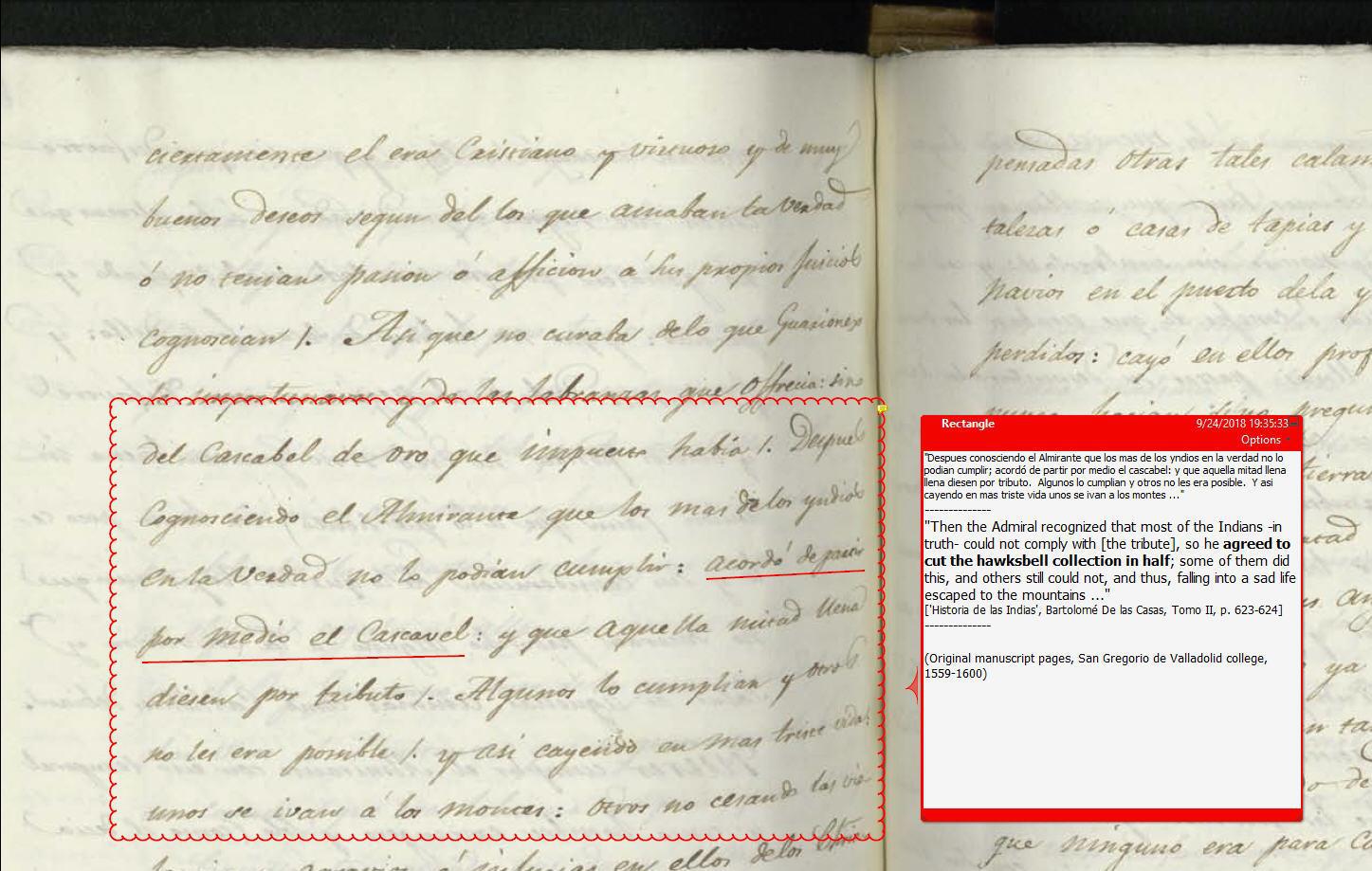
‘Historia de las Indias’, Bartolomé de las Casas Facsimile of Manuscript, 1559 Biblioteca San Gregorio de Valladolid
The underlined words state “…he agreed to cut the hawksbell collections in half…” This may be a possible source of the misunderstanding in interpreting the use of the word “cut” in its English translation. This word was used in regard to the amount of collections themselves that were imposed upon the Taíno as a form of punishment, not a reference about violent acts perpetrated upon them. On the contrary, the paragraph explains that their work was actually “cut” in half!
NOTE: It is interesting that in the Internet it is very hard to find an English-translated version of “Historia de las Indias” (History of the Indies). Regarding the above passage, the one place of all that you can find a translation equal to what is shown in the original De las Casas manuscript shown is the relation Washington Irving wrote in 1828- [The Life and Voyages of Christopher Columbus by Washington Irving: Vol. 2, Volume 2]
Exhibit C:
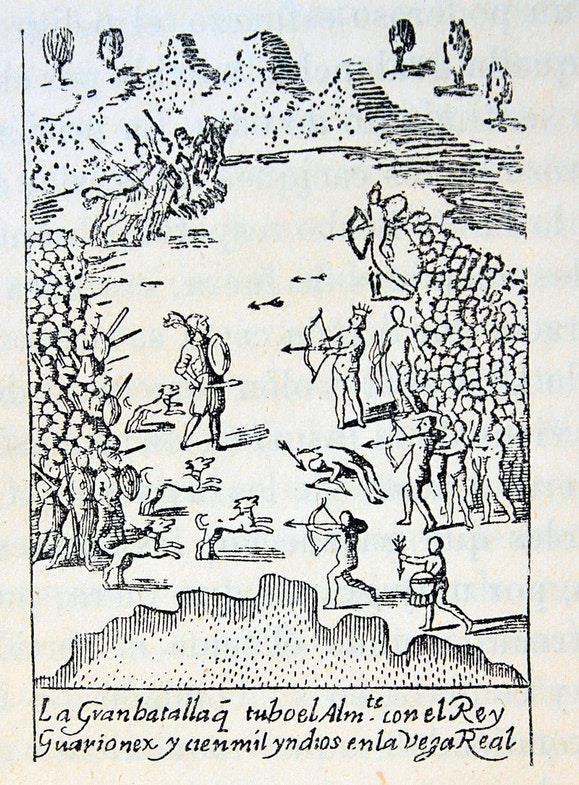
“La batalla en la Vega Real”
From the work “Historia General de Las Indias, Década Primera’ by Antonio de Herrera (1601)”
This illustration depicts the “Batalla del Santo Cerro en la Vega Real” as it was redacted in Herrera’s chronicle of the late XVI century. The book consists of the history of the discoveries, conquests and settlements of America in a narrative that spans over 100 years from the time of its publication. De las Casas also narrated the events that took place in Vega Real in several chapters of his ‘Historia de las Indias’ work.
Exhibit D:
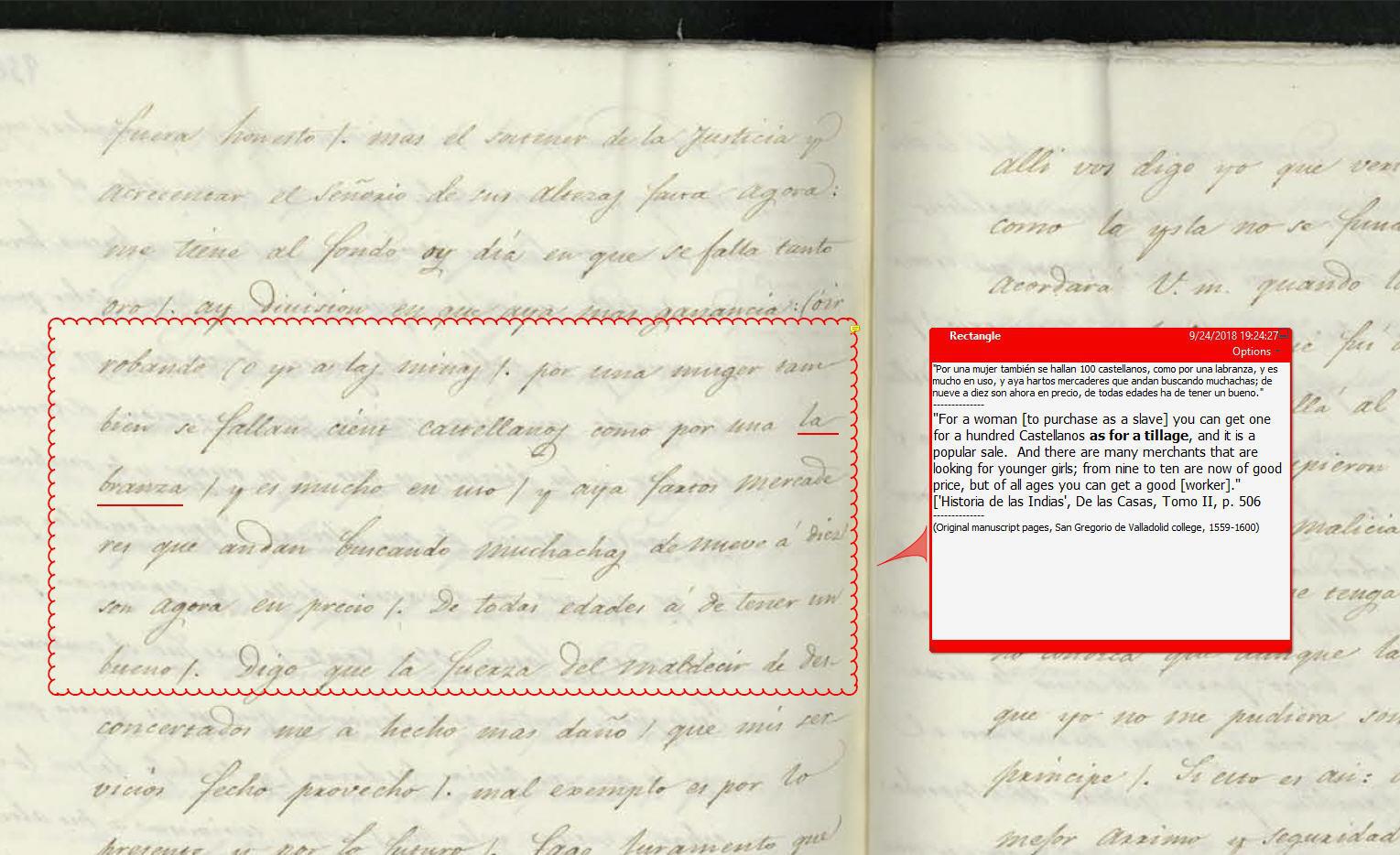
‘Historia de las Indias’, Bartolomé de las Casas Facsimile of Manuscript, 1559 Biblioteca San Gregorio de Valladolid
The correct translation of the word “labranza” in this paragraph is “tillage”. Consulted dictionary search results:
-Royal Spanish Academy Dictionary (RAE)
-Castilian Dictionary of XV Century Vocabulary Terms (under Dictionary/Search by lemma/labrança)
DEFINITION: LABRANZA = LABRANÇA (Derived from Latin LABORARE, 'to work'. Nebrija [Antonio de]* [c.1492]: Agricolaris. by way of tillage. Farming. ae. for laboring the field. Culture. ae. by the work. Epistles. ae. by the operator of tillage. Nebrija [Antonio de]*[ca. 1495]: Art of laboring the earth. rustic. Farming of land [in Greek]. georgicon. Labrança
cultus .us. cultio .onis. culture.
[*Original definitions from Antonio de Nebrija’s work- ‘Grammatica Antonii Nebrissensis’ (1492)]
You may be interested
-
2015 scholarship competition
The La Famiglia Scholarship committee is pleased to announce the financial aid competition...
-
Italian eateries make their mark in Montgome...
By Stephen Green While Tex-Mex is easily the most uniquely Texan food and barbecue is a u...
-
Visiting Italian POWs
by Suzanna Molino During World War II (1941–45), the U.S. Army had captured and s...
-
'Atmosphere of anger' in Glen Rock and beyond...
The debate over turning Columbus Day into Indigenous Peoples’ Day has people riled up on b...
-
'Augie' Miceli, longtime Calvert Hall footbal...
Augustine “Augie” Miceli Sr., the longest-tenured faculty member at Calvert Hall College H...
-
'Classic' Italian food at this Germantown res...
Chef Carmelo Gabriele is rolling out a new menu at the restaurant that he and his brother,...
-
'Columbus' ship Pinta docks in Fort Walton Be...
A little bit of living history will be on display in Fort Walton Beach now through Jan. 2....
-
'Don't Honor Genocide' Graffiti Painted on Co...
The statue of explorer Christopher Columbus that looms over Astoria Boulevard was vandaliz...



